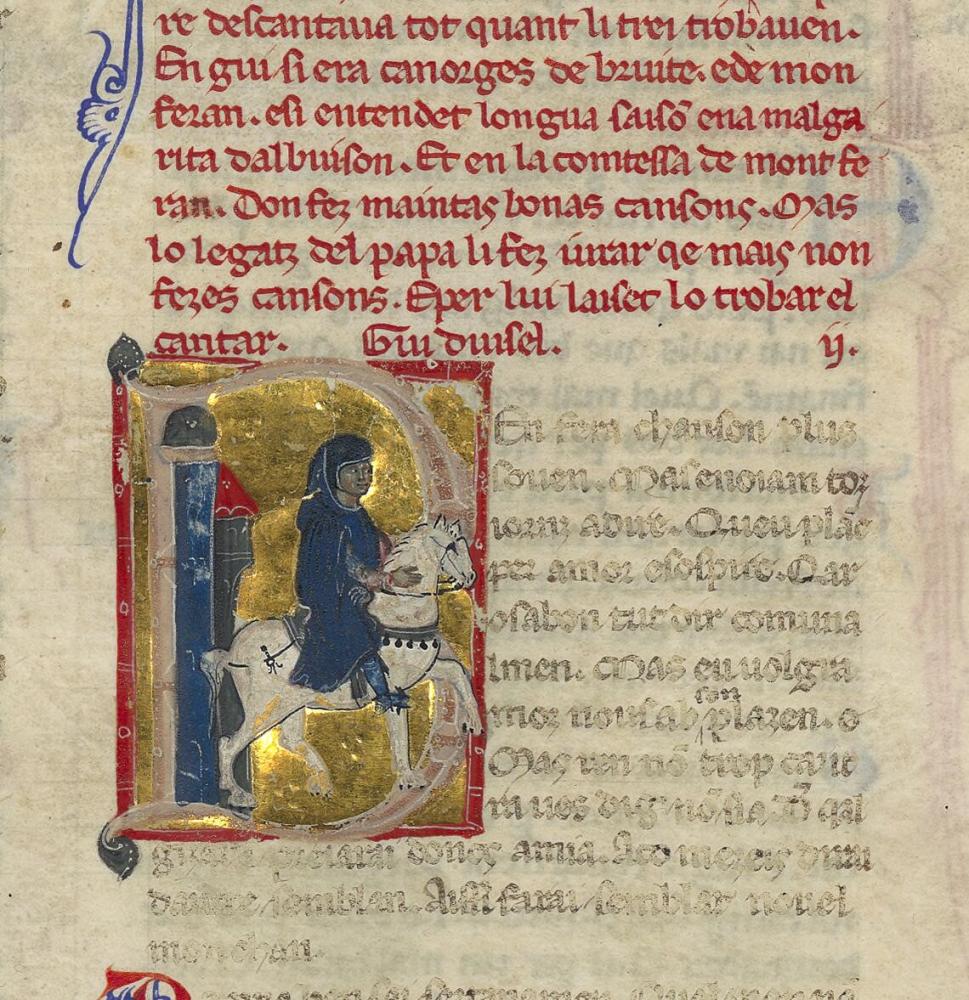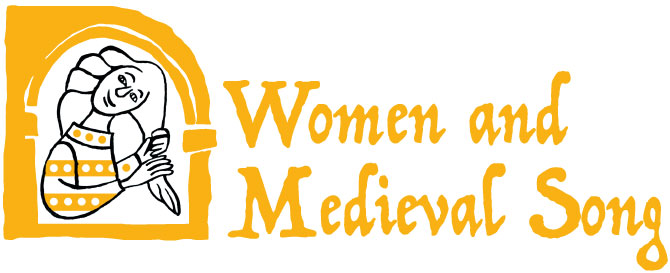Trobairitz is a term in Occitan, the language of southern France, for women who compose lyrics; trobairitz are the female counterparts to the troubadours; the noun trobairitz can be singular or plural. Some twenty women are known by name as composers of poetry in the south of France during the twelfth and thirteenth centuries, to which count must be added the authors of a number of anonymous works. The corpus consists of perhaps fifty lyrics, complete and fragmentary, but there is scholarly disagreement about the total number.
The trobairitz’s works provide insight into the lives and emotions of these authors, though we must be careful not to assume a direct correspondence between statements in the poetry and the lives of these medieval women. Most trobairitz were active in the period between 1180-1260; in general, we have little or no reliable biographical information for them.
The majority of these poets have only one lyric (and sometimes only one stanza) attributed to them; however, two of the women appear to have been more prolific. Castelloza and the Comtessa de Dia are each credited with four lyrics, and we have no way of knowing how much women’s poetry has been lost over time. Though it is most likely that all these compositions were intended to be sung, medieval manuscripts transmit music for only one of the trobairitz lyrics, the song A chantar m’er de so q’ieu no volria (BEdT 046,002) by the Comtessa de Dia.
The topics addressed in the trobairitz verses range from love and lovers to religion and politics. Note that the theme of love, especially adulterous love, in medieval Occitan verse is often more hypothetical than a historical reality. A good deal of the trobairitz corpus consists of debate poetry, where an often anonymous female interlocutor and a male partner discuss, in verse, an agreed-upon topic (it is possible that these have survived because of the male speaker’s presence in the verse).

Some examples
The precise identity of the Comtessa de Dia, sometimes named Beatritz de Dia (flourished end of the 12th century-beginning of the 13th) remains a subject of scholarly debate. What is certain is that she is credited with four songs, a fifth that is questionable; one of her lyrics has been transmitted with musical notation. The theme of her lyrics is love, seen from the woman’s point of view. She sings the praises of her lover in Ab joi et ab joven m’apais (BEdT 046,001); speaks of her anger vis-à-vis the man in A chantar m’er de so q’ieu no volria; regrets losing him in Estat ai en greu cossirier (BEdT 046,004); and dismisses gossips, a frequent topic in medieval Occitan verse, in one lyric: Fin joi me don'alegransa (BEdT 046,005).
It seems certain that Castelloza (flourished end of the 12th century-beginning of the 13th) was from the region of Auvergne and that she was married. Her songs speak of a woman’s woe in love. She pleads her case to her lover in one song and regrets her lover’s absence in another, though she admits that her husband is thankful her lover has gone away. The interest in these lyrics lies in how Castelloza turns themes used by male poets to represent the woman’s point of view.
While the trobairitz certainly explored the issues of love in all its facets in their solo and shared compositions, these medieval Occitan women also composed works with themes more exceptional for the period. For example, a poet whose name may be Beatritz or Bieris de Romans speaks to an otherwise unknown Lady Maria using language that has been interpreted by some as suggesting a lesbian relationship.
Gormonda de Montpellier is exceptional in the length (140 lines long) of her only work Greu m’es a durar (BEdT 177,001), a sirventes composed in 1228-1229 and defending the Catholic church in a time of a religious crusade against the Albigensian in the south of today’s France. This poem was written in response to a fierce attack on the church by her male contemporary Guilhem Figuiera; her political position in support of Catholicism during the Albigensian Crusade is exceptional in southern literary circles in this period. Her work is political and religious at the same time, using the poetic genre of the sirventes or diatribe.
In one lyric, Na Carenza al bel cors avinenz (BEdT 012,001 = 108,001), sisters Alais and Iselda ask Lady Carenza whether they should marry or remain virgins; she suggests they become brides of Christ. This lyric is often singled out for its realistic imagery relating to female life; one woman expresses very personal concerns, for instance over the toll of childbirth on women’s bodies and physical appearance, and offers unexpected realism for the period.
Stylistically, the women address their beloved directly more often than do the troubadours; they use more negative language and express frustration, deprivation, and strong feelings in general. These ladies are somewhat different from the women portrayed in troubadour lyric; the men sing of loves who are silent, distant, and unapproachable. But the trobairitz do not only use the troubadouresque lyrical masculine conventions presenting themselves as subjects of desire, but, going beyond the poetic codifications, introduce in their lyrics various aspects of the real world of the XIIth and XIIIth centuries women.
Conclusion
The twenty named trobairitz and the additional anonymous authors in the female voice account for roughly 5% of the lyricists in medieval Occitan, a distinct minority in a male-dominated literary culture. Nonetheless, they succeed in making the woman’s voice heard clearly, across a variety of lyric genres.
Suggested further reading
- Bec, Pierre, ed. and tr. 1995. Chants d’amour des femmes-troubadours. Paris: Stock.
- Bogin, Meg. 1976. The Women Troubadours: An Introduction to the Women Poets of 12th-century Provence and a Collection of their Poems. London: Paddington, 1976. [Les Trobairitz: poetes occitanes del segle XII. Barcelona: Horsori, 2006]
- Bruckner, Matilda T., Laurie Shepard, and Sarah White, eds. and trs. 1995. Songs of the Women Troubadours. New York / London: Garland.
- Nappholz, Carol Jane. 1994. Unsung Women: The Anonymous Female Voice in Troubadour Poetry. New York: Peter Lang.
- Paden, William D., ed. 1989. The Voice of the Trobairitz: Perspectives on the Women Troubadours. Philadelphia: University of Pennsylvania Press.
- Rieger, Angelica, ed. 1991. Trobairitz: Der Beitrag der Frau in der altokzitanischen höfischen Lyrik. Edition des Gesamtkorpus. Tübingen: M. Niemeyer.
